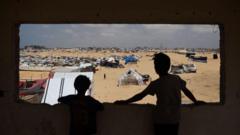
Grim Toll: Over 15,000 Children Reportedly Killed Since War's Onset
Devastating Impact on Civilian Population Deepens Humanitarian Crisis
Official sources have confirmed alarming reports detailing the devastating impact of the ongoing conflict on the civilian population, particularly its most vulnerable members: children. According to data released by leading humanitarian agencies, over 15,000 children have reportedly lost their lives since the war began. This staggering figure underscores the immense human cost of the conflict and highlights the urgent need for increased efforts to protect civilians and ensure their safety.
Unverified Reports and Data Collection Challenges
It is important to acknowledge that the reported number represents a conservative estimate. The actual figure may be significantly higher due to the inherent challenges in collecting and verifying information in active conflict zones. Access restrictions, security concerns, and the sheer scale of the devastation impede comprehensive data collection efforts. Many casualties likely go unreported, leaving a void in our understanding of the true extent of the tragedy.
Furthermore, the definition of "child" itself can be a complex issue in conflict settings. While international law generally defines a child as anyone under the age of 18, local cultural practices and the realities of war can blur these lines. The reported figures typically encompass all individuals under 18 years of age, but inconsistencies in reporting methodologies across different regions may exist.
Causes of Child Casualties: A Multifaceted Crisis
The causes of child casualties in the conflict are multifaceted and interconnected. Direct combat operations, including airstrikes, shelling, and ground fighting, account for a significant portion of the deaths. However, indirect consequences of the war, such as malnutrition, disease, and lack of access to essential healthcare services, also contribute substantially to the overall toll.
- Direct Violence: Children are often caught in the crossfire of armed clashes, making them vulnerable to injury and death.
- Unexploded Ordnance: The presence of landmines and other unexploded ordnance poses a constant threat to children, who may unknowingly trigger these devices while playing or traveling.
- Displacement and Malnutrition: The war has forced millions of people to flee their homes, leading to overcrowding in displacement camps and a shortage of food and clean water. This can lead to malnutrition, which weakens children's immune systems and makes them more susceptible to disease.
- Lack of Healthcare: The conflict has severely disrupted healthcare services, making it difficult for children to access essential medical care. This can lead to preventable deaths from common illnesses.
Long-Term Consequences and Psychological Trauma
Beyond the immediate loss of life, the war has had a profound and lasting impact on the surviving children. Many have witnessed horrific violence, lost family members, and been forced to flee their homes. These experiences can lead to severe psychological trauma, including anxiety, depression, and post-traumatic stress disorder (PTSD). The long-term consequences of this trauma can be devastating, hindering children's development and impacting their ability to lead healthy and productive lives.
International Response and Humanitarian Efforts
The international community has responded to the crisis with humanitarian assistance and diplomatic efforts. Organizations like the United Nations Children's Fund (UNICEF), the World Health Organization (WHO), and various non-governmental organizations (NGOs) are working tirelessly to provide aid to affected populations, including children. These efforts include providing food, water, shelter, medical care, and psychosocial support.
However, the scale of the crisis far exceeds the current capacity of humanitarian organizations. Increased funding, improved access to conflict zones, and a sustained commitment to protecting civilians are urgently needed to alleviate the suffering and prevent further loss of life.
The Path Forward: Towards Peace and Reconciliation
Ultimately, the only way to truly protect children from the ravages of war is to end the conflict. A negotiated settlement that addresses the underlying causes of the war and ensures the protection of civilians is essential. In the meantime, all parties to the conflict must adhere to international humanitarian law and take all feasible precautions to avoid civilian casualties. Furthermore, long-term investments in education, healthcare, and psychosocial support are needed to help children recover from the trauma of war and build a brighter future.
Recommendations
- Increased international funding for humanitarian assistance.
- Improved access to conflict zones for humanitarian organizations.
- Strict adherence to international humanitarian law by all parties to the conflict.
- Long-term investments in education, healthcare, and psychosocial support for children.
- A sustained commitment to finding a peaceful resolution to the conflict.
The international community must act decisively to protect children and alleviate their suffering. The future of an entire generation depends on it.
